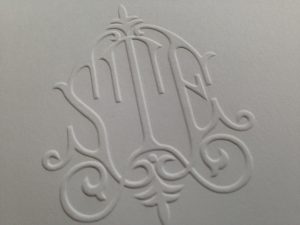Monogram Magic: Monogramania Hits Fever Pitch in the Victorian Age
In our previous blog, we explored the ancient history of the monogram. We saw that for centuries, people used monograms widely – on everything from coins to letters to homes and pottery. But people really went crazy for the monogram during the Victorian Era (1837-1901). In fact, one writer of the day called the art of collecting monograms an “epidemic” and named the monogram’s most ardent fans “monogramaniacs.”
What was going on? The Industrial Revolution ushered in a new middle class of factory owners, bankers, railroad managers, insurance agents, merchants and all the salaried professionals who helped run these businesses, as well as new ranks of civil servants, teachers, doctors and lawyers, according to Donna Loftus, author of “The Rise of the Victorian Middle Class.” Millions of people now had disposable income, and they desired some of the comforts of the upper classes. They began purchasing household goods as well as clothing, watches and jewelry, which the new economy had made more plentiful and affordable than ever before.
Celebrity and the Monogram
At the same time, the idea of celebrity took on power in popular culture. People began collecting crests and monograms of the rich and famous, according to Nancy Sharon Collins, author of The Complete Engraver.
Enthusiasts created albums of their most prized monograms, marks and seals. In this age of avid letter writing, “coats of arms or monograms from famous families, politicians, opera stars, or members of the theater were particularly coveted and displayed,” writes Collins.
Whole books explored and documented monogram design, such as An Encyclopedia of Monograms, published in 1884. The book included 5,000 decorative monograms to inspire artists and craftspeople.
Popular women’s magazines of the time, such as Godeys Lady’s Book and Peterson’s Magazine, regularly included alphabets, initials, names and monograms. Middle class readers copied them to embroider nearly every scrap of cloth – tablecloths, sheets, towels, pillowcases and clothing. “Hardly an item in her home escaped from being monogrammed,” writes Rita Weiss, editor of Victorian Alphabets, Monograms and Names. “Young girls learned how to embroider simple alphabets on the linens for her trousseau,” Weiss continues. “By the time she got married, her skills improved and she was ready for more expert work.”
Monogrammed Needlework Attains Art Status
The expert needlework skills attained by women – at all levels of society – and the invention of the Jacquard loom, which spurred faster and cheaper textile manufacturing, coincided to create the perfect circumstances for a boom in monogrammed linens like we’ve never seen before or since, according to Robin Molbert in Monograms and Antique Linens. “Bold and artful monogramming burst into vogue, serving as a kind of democratizing factor in the personalization of one’s linens,” writes Molbert. In England, France and the U.S., women formed sewing and embroidery circles to enjoy and support one another in their endeavors. They shared ideas and perfected their art, incorporating many other aspects including lacework, cut-outs, florals, animal figures and much more.
To this day, many people still cherish, value and collect antique linens from the Victorian Age. A rather funny example: In December 2016, a pair of Queen Victoria’s monogrammed bloomers went on auction, expected to be sold for £6,000. Some famous monograms developed by the Victorians continue to be in vogue. The world of consumer goods offers a perfect example: The interlocking L and V on Louis Vuitton’s bags and luggage. His son Georges designed the iconic image in 1896 to increase sales.
And the practice of monogramming continues to be popular. Whether it’s stationery or wine glasses, ornaments or napkins, personalizing one’s possessions conveys tradition and a sense of pride.
Our story about the monogram isn’t over. Next we ask: what exactly is a monogram?
Explore our lines of monogrammed Cards, Notes, Notepads, Napkins & Guest Towels, and all Monogrammed Items.
Sources:
Nancy Sharon Collins. The Complete Engraver: Monograms, Crests, Ciphers, Seals, and the Etiquette of Social Stationery. Princeton Architectural Press, 2012.
Donna Loftus. “The Rise of the Victorian Middle Class.” BBC History. Website.
Robin Molbert. “The Royal Lineage of Table Linens.” Monograms and Antique Linens. HM Books, 2016.
J. O’Kane. An Encyclopedia of Monograms. Originally published in 1884. Reprinted by Dover Publishing in 2003.
Rita Weiss, editor.Victorian Alphabets, Monograms and Names. Dover Publishing, 1974.





Leave a comment